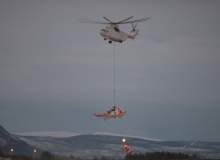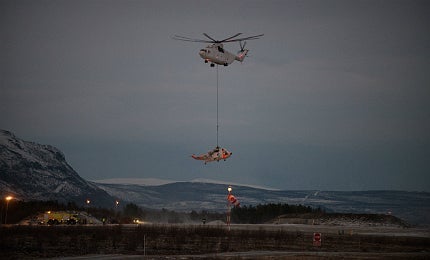
When a training exercise in the Arctic Circle goes awry, forcing a 6.5 tonne helicopter to make a crash landing atop a mountain, there are very few viable options for rescue. The barren and desolate terrain, coupled with poor conditions and extreme cold, is not exactly conducive to operations demanding precision.
However, this is exactly what happened when a Westland Sea King belonging to No. 330 Squadron of the Royal Norwegian Air Force encountered technical difficulties and had to make an emergency landing.
With the nearest road four miles away and the helicopter damaged beyond operable use, the only option was to rescue the rescue helicopter. Air Charter Service (ACS) defied the odds to pull off the operation in less than one hour.
Given the company’s experience in working with Russian load-bearing helicopters ACS, a global company offering private jet, commercial airliner and cargo aircraft charters, was perhaps the ideal candidate, but that isn’t to say such a rescue wasn’t unchartered territory.
ACS Cargo director Justin Lancaster says: "It’s the first time that ACS has completed a lift exactly like this, but we work with large Russian helicopters with internal loads on a more regular basis – predominantly during emergency relief operations to transfer aid to hostile and remote locations – and have completed sling loads before, but they are pretty rare."
How well do you really know your competitors?
Access the most comprehensive Company Profiles on the market, powered by GlobalData. Save hours of research. Gain competitive edge.

Thank you!
Your download email will arrive shortly
Not ready to buy yet? Download a free sample
We are confident about the unique quality of our Company Profiles. However, we want you to make the most beneficial decision for your business, so we offer a free sample that you can download by submitting the below form
By GlobalDataReceiving the call
"We received a call saying that the helicopter was on a training exercise and had experienced a rough landing. The nearest road was more than four miles away and the only way to retrieve it was to airlift it out," said Lancaster.
"The Sea King weighs around 6.5 tonnes, so we quickly decided that the best solution was a larger helicopter. We sourced the nearest Mil 26, which happened to be in Arkhangelsk in Russia, and positioned it into the nearby base."
The Mil 26, produced by Mil Moscow Helicopter Plant for the Russian Air Force, is the world’s most powerful series produced helicopter and, with its ability to lift more than 20 tonnes, became the ideal candidate for such a rescue. However, with just 316 of the Soviet-era helicopter ever built, could sourcing one in the requisite time frame become an operation in itself?
"We know several airlines with Mil 26s," confirmed Lancaster. "There are a couple of factors in sourcing one – it has to be out of contract and therefore available to work, and is near to the crash site. Luckily we were able to source on that met both of these requirements."
Precision planning
With the helicopter sourced, planning the rescue operation became paramount. With the extent of the damage to the helicopter and the land surrounding it still unknown, contingencies were also prepared.
"The plan was always to land next to the Sea King," explains Lancaster. "It makes it safer for all involved when connecting the two helicopters, as long as the ground next to the Sea King was suitable to land the Mil 26 – which it was deemed to be by an engineer from the airline who was sent in advance on a snowmobile."
As soon as the extent of the situation became known, meticulous plans were drawn up in order to ensure the rescue went ahead without a hitch. "It was a tricky load, but the careful planning that we put in really paid off," said Lancaster.
In preparation for the extraction, the helicopter’s rotor blades were removed and fuel drained, further reducing the weight of the downed vehicle and aiding the rescue. Despite every effort to make the rescue effort easier, it cannot be said the mission was without its risks.
Taking risks amid the snow and ice
Stabbursdalen National Park
"Landing a helicopter on a plateau 1,000m above sea level, with only a few hours daylight, in freezing conditions and snow and ice all around obviously present a variety of problems," explains Lancaster. The location of the downed helicopter, a plateau on Norway’s Div’gagai’sa, is located within Stabbursdalen National Park at the northern-most tip of Norway within the Arctic Circle and, as such, experiences bleak winters. In December, the average temperature is approximately -10°C and can plummet to depths as low as -28°C, increasing the associated dangers.
Further risks were associated with the helicopter itself, as Lancaster explains: "Another potential risk was that the Sea King was so badly damaged or for some reason was ‘stuck’ to the ground and could not be lifted."
Parts of the helicopter’s landing gear had broken upon impact, so there was a risk that this broken landing gear may have impaled itself into the ground with the crash, firmly lodging the helicopter stuck.
With the help of more than 40 people from various companies and organisations, including ACS, the airline from which the Mil-26 was sourced, the Norwegian military base in which the operation was handled and various handlers, the rescue mission was carried out without fail.
Described as a "very smooth operation that only lasted one hour in total" by Lancaster, the Mil-26 was able to land next to the stricken Sea King before lifting it off from the mountain and to Banak Air Station.
Having crashed on 11 December 2012, its return to the air base on 23 December 2012 marked the successful completion of an operation almost two weeks in the making.
Related content
Video feature: Gulfstream, Bombardier and Embraer – the business jet battle
Having slumped into an almost terminal decline during the global recession, green shoots of recovery are now evident within the business jet market.
Video feature: Bigelow Aerospace unveils inflatable space station module
A stay in space for astronauts and tourists alike could soon take place within an inflatable module fixed to the side of the ISS.





